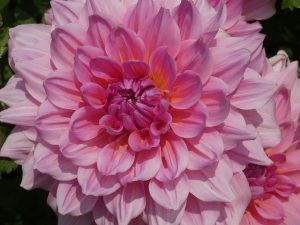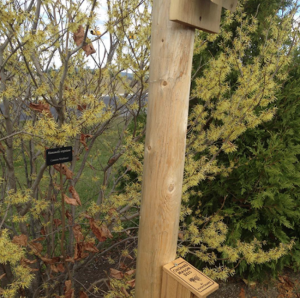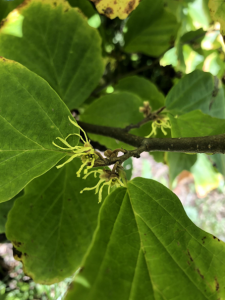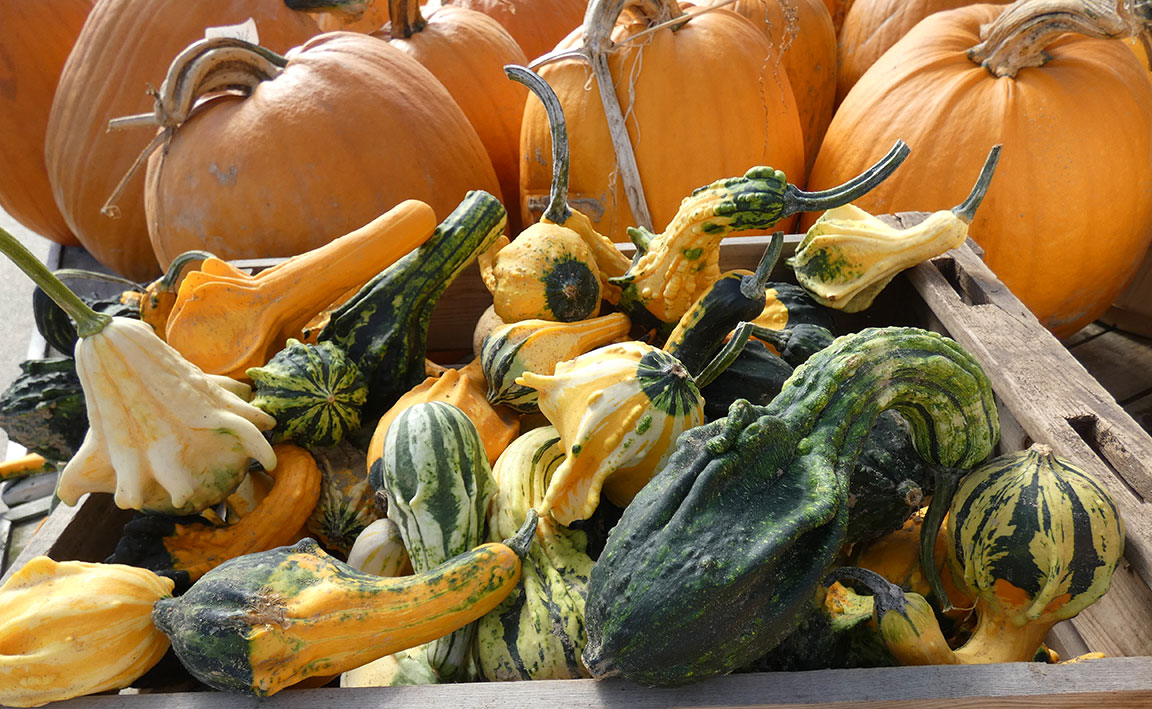
Maine Home Garden News — October 2021
In This Issue:
- October Is the Month to . . .
- Mushrooms on Lawns
- Obsolete Pesticide Disposal
- Vagrant Hummingbirds
- A Review of Northeastern Garden Book (Sunset Publishing Corp., 2001)
- Common Witchhazel (Hamamelis virginiana)
- Eye-Spotted Lady Beetle (Anatis mali)
- Reader Exchange — Making Lemonade Out of Lemons
October Is the Month to . . .
By Kate Garland, Horticulturist, UMaine Extension Penobscot County
- Dig dahlias. When cold temperatures kill the top growth on your dahlias, mark your calendars two weeks out for digging day. This time left in the ground after the frost allows the tubers to continue to develop and cure for better storage results. If you’re reading this and the frost hasn’t hit, remove any weak or poor performing plants to avoid taking up precious storage space with less desirable plant material.
- Harvest sweet potatoes. Sweet potatoes are a great crop for Maine gardens and will continue to develop right up until frost kills the vines. Be gentle as you harvest and take the time to cure them before storing to ensure a longer shelf life.
- Prepare a hole for your live Christmas tree. Live Christmas trees require patience and planning in order to ensure greater success when transitioning it to its final home in your landscape. They should be planted in the ground as soon as you are done enjoying them indoors. As you would expect, it’s much easier to get a planting hole ready now compared to the conditions you’ll encounter after the holiday season.
- Safely dispose of obsolete pesticides. Sign up by October 8 to take advantage of this important free program with the Maine Board of Pesticides Control. Learn more in the article below.
- Plant garlic. Garlic is an easy crop to love for many reasons. It requires very little maintenance, has relatively few pests and a long shelf-life, is fun to plant as the season comes to a close, and is equally fun to enjoy in savory dishes all winter long. Wait until the weather cools before planting the cloves. Our bulletin #2063, Growing Hardneck Garlic in Your Maine Garden has some very helpful planting instructions and videos.
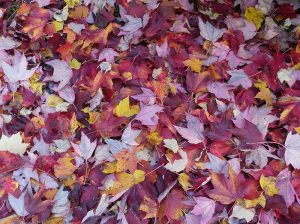 Leave the leaves. We’ve said it before and we’ll say it again. It bears repeating that this practice will have a great impact on the survival of countless insects that rely on leaf litter for overwintering protection. Countless species of moths, butterflies, and bees rely on this natural cover to complete their life cycle.
Leave the leaves. We’ve said it before and we’ll say it again. It bears repeating that this practice will have a great impact on the survival of countless insects that rely on leaf litter for overwintering protection. Countless species of moths, butterflies, and bees rely on this natural cover to complete their life cycle.
- Water in newly planted perennials. Fall is a great time to plant, but providing ample water going into the colder months is key to overwintering success.
- Take garden measurements. Winter is an important planning time and accurate measurements are incredibly helpful to have on hand when mapping out your garden for the season ahead.
- Store leftover seeds. Don’t toss out those extra seeds! Many seeds stay viable for several years if stored in a cool, dry location. The back of your refrigerator in a watertight jar is a perfect spot for your seed stash. With that said, don’t bother storing onion family seeds. Their viability drops dramatically after the first year.
Mushrooms on Lawns
By Dr. Seanna Annis, University of Maine Associate Professor of Mycology and Associate Extension Professor
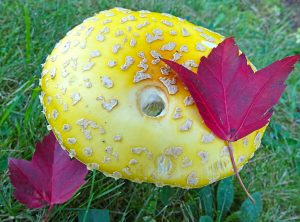 With the rain we have been getting this fall, we are seeing fungi popping up in peoples’ yards, fields, and woods all over the state. These fungi typically have been present for years, growing underground until they have sufficient nutrients and water to produce their fruiting body or mushroom where we can see it. The fruiting body is equivalent to a fruit on a plant and helps the fungus disperse itself through spores to new environments. Most fruiting bodies last less than a week since they release spores that are dispersed by wind for a few days and then rot from other fungi or bacteria eating them. The fungus under the surface of the ground supporting the production of the fruiting bodies consists of fine strands called hyphae. The hyphae form a much larger and longer living structure than the fruiting body and can persist for years or decades.
With the rain we have been getting this fall, we are seeing fungi popping up in peoples’ yards, fields, and woods all over the state. These fungi typically have been present for years, growing underground until they have sufficient nutrients and water to produce their fruiting body or mushroom where we can see it. The fruiting body is equivalent to a fruit on a plant and helps the fungus disperse itself through spores to new environments. Most fruiting bodies last less than a week since they release spores that are dispersed by wind for a few days and then rot from other fungi or bacteria eating them. The fungus under the surface of the ground supporting the production of the fruiting bodies consists of fine strands called hyphae. The hyphae form a much larger and longer living structure than the fruiting body and can persist for years or decades.
Most of these fungi are providing valuable services to the plants near them. Many of these fungi are breaking down dead plant material and returning valuable nutrients, such as nitrogen and phosphorus, to the soil for plants to use. Some fungi have a more direct role in interacting with plants and are in a mutually beneficial symbiosis with plant roots, particularly shrubs and trees, called mycorrhizae. Mycorrhizal roots have fungus growing around or in the roots in close contact with plant cells and the hyphae extended out into the soil around the plant. The fungus collects nitrogen, phosphorus, other nutrients and water and gives it to the plant through the mycorrhizal roots. The plant, in turn, gives plant sugars to the fungus to grow. It is estimated that 90% of plant families have mycorrhizal roots. Many mycorrhizal fungi also protect the plant against fungi that cause root rot or other organisms, such as bacteria and plant pathogenic nematodes (microscopic worms), and improve soil quality. Without mycorrhizal fungi, many plants do not thrive and many cannot grow in the forests, bogs, and other ecosystems in Maine.
Many landowners ask how to get rid of the fruiting bodies on their lawn. Unfortunately there is no way of doing this without removing all of your plant. Spraying fungicides on the lawn will not penetrate down to where these fungi are growing and may damage beneficial fungi and plant roots. Fungi are inhabitants of all soil types and usually are interacting in a beneficial way with nearby plants. The fruiting bodies should only be around for about a week or two and can be safely removed and thrown in the compost or garbage. Do NOT eat any fungus unless you have confirmed with a mushroom expert that it is edible. If you eat most of the fruiting bodies growing on lawns, they will give you diarrhea and vomiting, that can be severe, but eating the fruiting bodies of some fungi can cause severe poisoning with damage to the major organs, particularly the liver and kidneys, and can result in death.
Obsolete Pesticide Disposal
Maine Collecting Unwanted Pesticides Free of Charge
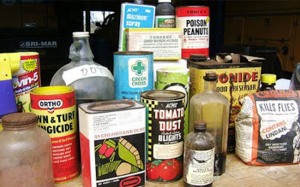
AUGUSTA—The Obsolete Pesticide Collection Program protects Maine’s natural resources and prevents agriculture pollution by promoting the safe and proper disposal of outdated, unused, or unwanted pesticides. The program is made possible by the Maine Department of Agriculture, Conservation and Forestry’s Board of Pesticides Control (BPC) and the Maine Department of Environmental Protection. The program is open to homeowners and family-owned farms who are encouraged to bring unwanted pesticides — including herbicides, insecticides, rodenticides, fungicides, and similar products used in agricultural production or around the home to collection sites in Presque Isle, Bangor, Augusta, and Portland. Pre-registration is required by October 8 to participate, drop-ins are not permitted, and drop-off locations will be announced soon.
Details including registering and providing the obsolete pesticides inventory form, a list of banned and unusable products, storage and transportation guidelines, and other disposal options, are found on the Board of Pesticides Control website.
About Maine’s Obsolete Pesticide Collection Program
Removal of obsolete and unwanted pesticides is important for protecting the public, wildlife, and environmental health. Improper pesticide handling and disposal, such as placing it in the trash or pouring it down the drain, can contaminate land and water resources. The Maine Obsolete Pesticide Collection Program ensures that such pesticides are handled properly. Since 1982, the program has saved more than 250,000 lbs. of pesticides from entering the waste stream. Collected pesticides are taken to licensed, out-of-state disposal facilities by the federal Environmental Protection Agency. Learn more on, How to participate.
Vagrant Hummingbirds
By Doug Hitchcox, Maine Audubon Staff Naturalist
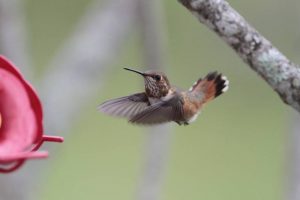 Although the majority of our Ruby-throated Hummingbirds will have departed for Central America by early October, the hummingbird feeders and late blooming flowers in your yard can act as an important fueling station for late migrants or as an attractant for vagrants from the west. We are increasingly seeing western species like Rufous Hummingbirds coming east in the fall. Most sightings are birds visiting feeders that are left up through October and even November, or from bright red tubular flowers, like Pineapple Sage (Salvia elegans). I recommend keeping feeders up until just before you think the sugar water would freeze. And then shoot me an email (naturalist@maineaudubon.org) if you see any hummingbirds after the first week of October!
Although the majority of our Ruby-throated Hummingbirds will have departed for Central America by early October, the hummingbird feeders and late blooming flowers in your yard can act as an important fueling station for late migrants or as an attractant for vagrants from the west. We are increasingly seeing western species like Rufous Hummingbirds coming east in the fall. Most sightings are birds visiting feeders that are left up through October and even November, or from bright red tubular flowers, like Pineapple Sage (Salvia elegans). I recommend keeping feeders up until just before you think the sugar water would freeze. And then shoot me an email (naturalist@maineaudubon.org) if you see any hummingbirds after the first week of October!
For more on the importance of Maine native plants to support birds and other wildlife, visit Maine Audubon’s “Bringing Nature Home” webpage.
A Review of Northeastern Garden Book
(Sunset Publishing Corp., 2001)
Reviewer: Clara Ross, Penobscot County Master Gardener Volunteer
What makes a person prefer one book over another? What gives value to a certain book? As gardeners, I imagine all of us have had an opportunity to open a particular gardening book, look it over, and say, “Wow…this is it!” The Northeastern Garden Book does that for me. I have turned to it again and again because I can count on it giving me ideas and answers. It is not only a comprehensive guide, but is also easy to understand and to utilize.
Specifically, this book is a plant encyclopedia with over 6,000 (I didn’t count; that was the editor reporting!) plant varieties cross referenced with scientific and common names and accompanied by drawings. There is a plant selection section with photographs based on particular needs/advantages/characteristics (shady, fragrant, showy and cutting flowers, seasonal color, ground covers/lawn substitutes, hedges/screens, and many more). There are sections on landscape planning, weeds, pests, plant disorders, composting, containers, propagation, pruning, tools, and more.
One of my favorite sections is called “Demystifying Scientific Plant Names” (borealis = northern; officinalis = medicinal). Another favorite is a pronunciation guide (cotoneaster = kuh-toe-nee-AS-tuhr).
I especially like that there are two extensive indexes: one is a plant name index, while the other includes gardening topics, all cross-referenced. One down-side of the book is that it includes all northeastern zones (including my sisters’ gardens in southeastern Pennsylvania), so beware if you see a plant you like, only to find it’s not good for our Maine zone.
I’ve had my copy for years; purchased at a used book sale for a couple of dollars. I have bought several copies for relatives and friends for only a dollar or two. I saw the current new book online (published as a paperback only) for over $50.00. It’s worth that to me, but I believe you will find a used copy somewhere for small change.
Common Witchhazel (Hamamelis virginiana)
By Wanda Greatorex, Penobscot County Master Gardener Volunteer
Native to much of the eastern half of North America, this lovely shrub freely forms dense clumps or can be trained early into a single trunk. Either form has the potential to reach heights ranging from 6-20’ tall depending on the growing conditions.
Mildly fragrant yellow flowers bloom shockingly late; appearing in October after the oval dark green summer foliage turns an autumnal buttercup yellow. The wispy yellow blooms linger longer than the fall foliage, allowing them to be visible into late October.
Witchhazel was used by indigenous people for food, medicine, and sacred ceremonies. Historical records note that the Algonquin used the wood for crafting bows.
This plant serves as a host to 63 species of caterpillars, attracts bees, and is tolerant of compacted and wet soils. It’s noted as being deer and rabbit resistant. Witchhazel works well as a hedge or on its own as a specimen plant. Being tolerant of full sun to full shade, this fall beauty is a great option to consider for nearly any Maine landscape.
- Flowers are fully visible after leaf drop. Photo taken on October 22 at the Eastern Maine Native Plant Arboretum in Bangor.
- The fruits take an entire year to fully ripen and are prominent at the same time as the flowers the following fall. When fully developed, they literally launch two shiny black seeds up to 40’ away from the parent plant. Photo taken on September 29 in Bangor.
- Newly unfurled flowers and flower buds. Photo taken on September 29 in Bangor.
Eye-Spotted Lady Beetle (Anatis mali)
By Linda Sowers, Aroostook County Master Gardener Volunteer
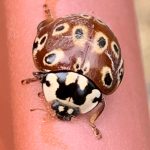 The eye-spotted lady beetle lives in the forest canopy and is native across the northern part of the US and southern Canada.
The eye-spotted lady beetle lives in the forest canopy and is native across the northern part of the US and southern Canada.
The brown elytra (wing covers) on these round, almost helmet-shaped insects have several black spots, each distinctively ringed in yellow. As they age, the contrast between brown and yellow becomes more pronounced.
Much like their other lady beetle relatives, they are ravenous predators of aphids. A ladybug is capable of devouring thousands of aphids during their lifetime, making it a welcome guest in any garden.
Reader Exchange — Making Lemonade Out of Lemons (or Infrastructure Out of Invasives)
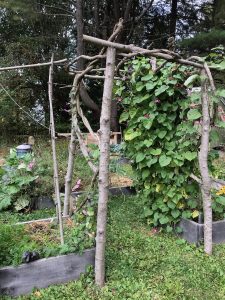
By Alice Elliott
“Asiatic bittersweet had run wild on our new property, killing many trees. We removed many trees and large bittersweet vines; some of the trees were fantastically shaped due to the strangling vines. We used the trees and vines to build an arbor into the vegetable garden area. It is incredibly satisfying to see the dead bittersweet in use for the purpose.”
Our readers have a lot of experience and great ideas. Therefore, we decided it’s high time you chimed in with some of your favorite gardening tips and tricks. Each month, we’ll challenge you to send us gardening “hacks” that make your horticultural life more fun and productive. If your submission is selected, we’ll provide you with a free soil test with the Maine Soil Testing Service. Submit your ideas to katherine.garland@maine.edu with the email subject “Reader Exchange”.
Do you appreciate the work we are doing?
Consider making a contribution to the Maine Master Gardener Development Fund. Your dollars will support and expand Master Gardener Volunteer community outreach across Maine.
Your feedback is important to us!
We appreciate your feedback and ideas for future Maine Home Garden News topics. We look forward to sharing new information and inspiration in future issues.
Subscribe to Maine Home Garden News
Let us know if you would like to be notified when new issues are posted. To receive e-mail notifications, click on the Subscribe button below.
University of Maine Cooperative Extension’s Maine Home Garden News is designed to equip home gardeners with practical, timely information.
For more information or questions, contact Kate Garland at katherine.garland@maine.edu or 1.800.287.1485 (in Maine).
Visit our Archives to see past issues.
Maine Home Garden News was created in response to a continued increase in requests for information on gardening and includes timely and seasonal tips, as well as research-based articles on all aspects of gardening. Articles are written by UMaine Extension specialists, educators, and horticulture professionals, as well as Master Gardener Volunteers from around Maine, with Katherine Garland, UMaine Extension Horticulturalist in Penobscot County, serving as editor. Special thanks to our 2020 Master Gardener Volunteer co-editors Naomi Jacobs and Abby Zelz.
Information in this publication is provided purely for educational purposes. No responsibility is assumed for any problems associated with the use of products or services mentioned. No endorsement of products or companies is intended, nor is criticism of unnamed products or companies implied.
© 2021
Call 800.287.0274 (in Maine), or 207.581.3188, for information on publications and program offerings from University of Maine Cooperative Extension, or visit extension.umaine.edu.
The University of Maine is an EEO/AA employer, and does not discriminate on the grounds of race, color, religion, sex, sexual orientation, transgender status, gender expression, national origin, citizenship status, age, disability, genetic information or veteran’s status in employment, education, and all other programs and activities. The following person has been designated to handle inquiries regarding non-discrimination policies: Director of Equal Opportunity, 101 North Stevens Hall, University of Maine, Orono, ME 04469-5754, 207.581.1226, TTY 711 (Maine Relay System).

